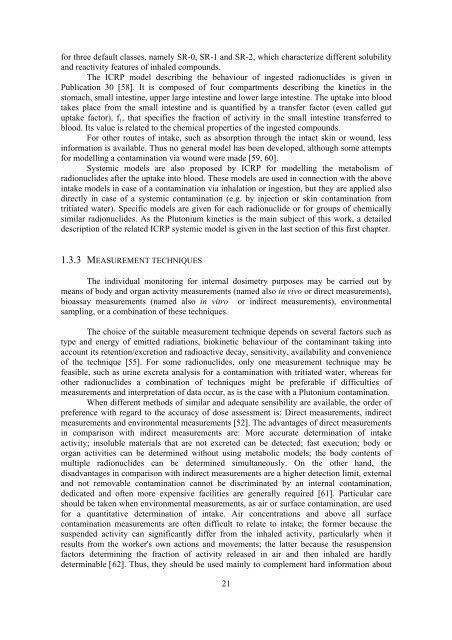Plutonium Biokinetics in Human Body A. Luciani - Kit-Bibliothek - FZK
Plutonium Biokinetics in Human Body A. Luciani - Kit-Bibliothek - FZK
Plutonium Biokinetics in Human Body A. Luciani - Kit-Bibliothek - FZK
You also want an ePaper? Increase the reach of your titles
YUMPU automatically turns print PDFs into web optimized ePapers that Google loves.
for three default classes, namely SR-0, SR-1 and SR-2, which characterize different solubility<br />
and reactivity features of <strong>in</strong>haled compounds.<br />
The ICRP model describ<strong>in</strong>g the behaviour of <strong>in</strong>gested radionuclides is given <strong>in</strong><br />
Publication 30 [58]. It is composed of four compartments describ<strong>in</strong>g the k<strong>in</strong>etics <strong>in</strong> the<br />
stomach, small <strong>in</strong>test<strong>in</strong>e, upper large <strong>in</strong>test<strong>in</strong>e and lower large <strong>in</strong>test<strong>in</strong>e. The uptake <strong>in</strong>to blood<br />
takes place from the small <strong>in</strong>test<strong>in</strong>e and is quantified by a transfer factor (even called gut<br />
uptake factor), f 1, that specifies the fraction of activity <strong>in</strong> the small <strong>in</strong>test<strong>in</strong>e transferred to<br />
blood. Its value is related to the chemical properties of the <strong>in</strong>gested compounds.<br />
For other routes of <strong>in</strong>take, such as absorption through the <strong>in</strong>tact sk<strong>in</strong> or wound, less<br />
<strong>in</strong>formation is available. Thus no general model has been developed, although some attempts<br />
for modell<strong>in</strong>g a contam<strong>in</strong>ation via wound were made [59, 60].<br />
Systemic models are also proposed by ICRP for modell<strong>in</strong>g the metabolism of<br />
radionuclides after the uptake <strong>in</strong>to blood. These models are used <strong>in</strong> connection with the above<br />
<strong>in</strong>take models <strong>in</strong> case of a contam<strong>in</strong>ation via <strong>in</strong>halation or <strong>in</strong>gestion, but they are applied also<br />
directly <strong>in</strong> case of a systemic contam<strong>in</strong>ation (e.g. by <strong>in</strong>jection or sk<strong>in</strong> contam<strong>in</strong>ation from<br />
tritiated water). Specific models are given for each radionuclide or for groups of chemically<br />
similar radionuclides. As the <strong>Plutonium</strong> k<strong>in</strong>etics is the ma<strong>in</strong> subject of this work, a detailed<br />
description of the related ICRP systemic model is given <strong>in</strong> the last section of this first chapter.<br />
1.3.3 MEASUREMENT TECHNIQUES<br />
The <strong>in</strong>dividual monitor<strong>in</strong>g for <strong>in</strong>ternal dosimetry purposes may be carried out by<br />
means of body and organ activity measurements (named also <strong>in</strong> vivo or direct measurements),<br />
bioassay measurements (named also <strong>in</strong> vitro or <strong>in</strong>direct measurements), environmental<br />
sampl<strong>in</strong>g, or a comb<strong>in</strong>ation of these techniques.<br />
The choice of the suitable measurement technique depends on several factors such as<br />
type and energy of emitted radiations, biok<strong>in</strong>etic behaviour of the contam<strong>in</strong>ant tak<strong>in</strong>g <strong>in</strong>to<br />
account its retention/excretion and radioactive decay, sensitivity, availability and convenience<br />
of the technique [55]. For some radionuclides, only one measurement technique may be<br />
feasible, such as ur<strong>in</strong>e excreta analysis for a contam<strong>in</strong>ation with tritiated water, whereas for<br />
other radionuclides a comb<strong>in</strong>ation of techniques might be preferable if difficulties of<br />
measurements and <strong>in</strong>terpretation of data occur, as is the case with a <strong>Plutonium</strong> contam<strong>in</strong>ation.<br />
When different methods of similar and adequate sensibility are available, the order of<br />
preference with regard to the accuracy of dose assessment is: Direct measurements, <strong>in</strong>direct<br />
measurements and environmental measurements [52]. The advantages of direct measurements<br />
<strong>in</strong> comparison with <strong>in</strong>direct measurements are: More accurate determ<strong>in</strong>ation of <strong>in</strong>take<br />
activity; <strong>in</strong>soluble materials that are not excreted can be detected; fast execution; body or<br />
organ activities can be determ<strong>in</strong>ed without us<strong>in</strong>g metabolic models; the body contents of<br />
multiple radionuclides can be determ<strong>in</strong>ed simultaneously. On the other hand, the<br />
disadvantages <strong>in</strong> comparison with <strong>in</strong>direct measurements are a higher detection limit, external<br />
and not removable contam<strong>in</strong>ation cannot be discrim<strong>in</strong>ated by an <strong>in</strong>ternal contam<strong>in</strong>ation,<br />
dedicated and often more expensive facilities are generally required [61]. Particular care<br />
should be taken when environmental measurements, as air or surface contam<strong>in</strong>ation, are used<br />
for a quantitative determ<strong>in</strong>ation of <strong>in</strong>take. Air concentrations and above all surface<br />
contam<strong>in</strong>ation measurements are often difficult to relate to <strong>in</strong>take; the former because the<br />
suspended activity can significantly differ from the <strong>in</strong>haled activity, particularly when it<br />
results from the worker's own actions and movements; the latter because the resuspension<br />
factors determ<strong>in</strong><strong>in</strong>g the fraction of activity released <strong>in</strong> air and then <strong>in</strong>haled are hardly<br />
determ<strong>in</strong>able [62]. Thus, they should be used ma<strong>in</strong>ly to complement hard <strong>in</strong>formation about<br />
21












![{A1[]Sp - Bibliothek](https://img.yumpu.com/21908054/1/184x260/a1sp-bibliothek.jpg?quality=85)




